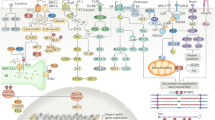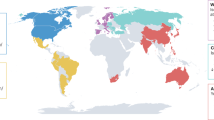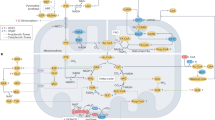Abstract
Over half of patients with heart failure have a preserved ejection fraction (>50%, called HFpEF), a syndrome with substantial morbidity/mortality and few effective therapies1. Its dominant comorbidity is now obesity, which worsens disease and prognosis1,2,3. Myocardial data from patients with morbid obesity and HFpEF show depressed myocyte calcium-stimulated tension4 and disrupted gene expression of mitochondrial and lipid metabolic pathways5,6, abnormalities shared by human HF with a reduced EF but less so in HFpEF without severe obesity. The impact of severe obesity on human HFpEF myocardial ultrastructure remains unexplored. Here we assessed the myocardial ultrastructure in septal biopsies from patients with HFpEF using transmission electron microscopy. We observed sarcomere disruption and sarcolysis, mitochondrial swelling with cristae separation and dissolution and lipid droplet accumulation that was more prominent in the most obese patients with HFpEF and not dependent on comorbid diabetes. Myocardial proteomics revealed associated reduction in fatty acid uptake, processing and oxidation and mitochondrial respiration proteins, particularly in very obese patients with HFpEF.
This is a preview of subscription content, access via your institution
Access options
Subscribe to this journal
Receive 12 digital issues and online access to articles
$119.00 per year
only $9.92 per issue
Buy this article
- Purchase on SpringerLink
- Instant access to full article PDF
Prices may be subject to local taxes which are calculated during checkout


Similar content being viewed by others
Data availability
The human HFpEF and control RNA sequencing databases are publicly available at https://doi.org/10.5281/zenodo.4287234 (ref. 43), and the proteomic database is publicly available at https://www.ebi.ac.uk/pride/archive/projects/PXD045677. The micrographs are also available at https://doi.org/10.5281/zenodo.12191847 (ref. 44). Source data are provided with this paper. Any additional data requests can be addressed to the corresponding author D.A.K.
References
Borlaug, B. A., Sharma, K., Shah, S. J. & Ho, J. E. Heart failure with preserved ejection fraction: JACC Scientific Statement. J. Am. Coll. Cardiol. 81, 1810–1834 (2023).
Borlaug, B. A. et al. Obesity and heart failure with preserved ejection fraction: new insights and pathophysiological targets. Cardiovasc. Res. 118, 3434–3450 (2023).
Aryee, E. K., Ozkan, B. & Ndumele, C. E. Heart failure and obesity: the latest pandemic. Prog. Cardiovasc. Dis. 78, 43–48 (2023).
Aslam, M. I. et al. Reduced right ventricular sarcomere contractility in heart failure with preserved ejection fraction and severe obesity. Circulation 143, 965–967 (2021).
Hahn, V. S. et al. Myocardial gene expression signatures in human heart failure with preserved ejection fraction. Circulation 143, 120–134 (2021).
Hahn, V. S. et al. Myocardial metabolomics of human heart failure with preserved ejection fraction. Circulation 147, 1147–1161 (2023).
Zile, M. R. et al. Myocardial stiffness in patients with heart failure and a preserved ejection fraction: contributions of collagen and titin. Circulation 131, 1247–1259 (2015).
Chaanine, A. H. et al. Mitochondrial morphology, dynamics, and function in human pressure overload or ischemic heart disease with preserved or reduced ejection fraction. Circ. Heart Fail. 12, e005131 (2019).
Redfield, M. M. & Borlaug, B. A. Heart failure with preserved ejection fraction: a review. JAMA 329, 827–838 (2023).
Kittleson, M. M. et al. 2023 ACC Expert Consensus Decision Pathway on management of heart failure with preserved ejection fraction: a report of the American College of Cardiology Solution Set Oversight Committee. J. Am. Coll. Cardiol. 81, 1835–1878 (2023).
Anker, S. D. et al. Empagliflozin in heart failure with a preserved ejection fraction. N. Engl. J. Med. 385, 1451–1461 (2021).
Solomon, S. D. et al. Dapagliflozin in heart failure with mildly reduced or preserved ejection fraction. N. Engl. J. Med. 387, 1089–1098 (2022).
Kosiborod, M. N. et al. Semaglutide in patients with heart failure with preserved ejection fraction and obesity. N. Engl. J. Med. 389, 1069–1084 (2023).
Pinto, Y. M. Heart failure with preserved ejection fraction—a metabolic disease? N. Engl. J. Med. 389, 1145–1146 (2023).
Hahn, V. S. et al. Endomyocardial biopsy characterization of heart failure with preserved ejection fraction and prevalence of cardiac amyloidosis. JACC Heart Fail. 8, 712–724 (2020).
Jani, V. et al. Right ventricular sarcomere contractile depression and the role of thick filament activation in human heart failure with pulmonary hypertension. Circulation 147, 1919–1932 (2023).
Flam, E. et al. Integrated landscape of cardiac metabolism in end-stage human nonischemic dilated cardiomyopathy. Nat. Cardiovasc. Res. 1, 817–829 (2022).
Schaper, J. et al. Impairment of the myocardial ultrastructure and changes of the cytoskeleton in dilated cardiomyopathy. Circulation 83, 504–514 (1991).
Saito, T. et al. Ultrastructural features of cardiomyocytes in dilated cardiomyopathy with initially decompensated heart failure as a predictor of prognosis. Eur. Heart J. 36, 724–732 (2015).
Sharov, V. G. et al. Abnormalities of contractile structures in viable myocytes of the failing heart. Int. J. Cardiol. 43, 287–297 (1994).
Ahuja, P. et al. Divergent mitochondrial biogenesis responses in human cardiomyopathy. Circulation 127, 1957–1967 (2013).
Collins, H. E. et al. Mitochondrial morphology and mitophagy in heart diseases: qualitative and quantitative analyses using transmission electron microscopy. Front. Aging 2, 670267 (2021).
D’Souza, K., Nzirorera, C. & Kienesberger, P. C. Lipid metabolism and signaling in cardiac lipotoxicity. Biochim. Biophys. Acta 1861, 1513–1524 (2016).
Nakamura, M. & Sadoshima, J. Cardiomyopathy in obesity, insulin resistance and diabetes. J. Physiol. 598, 2977–2993 (2020).
Koleini, N. et al. Landscape of glycolytic metabolites and their regulating proteins in myocardium from human heart failure with preserved ejection fraction. Eur. J. Heart Fail. (in the press).
Maron, B. J., Ferrans, V. J. & Roberts, W. C. Ultrastructural features of degenerated cardiac muscle cells in patients with cardiac hypertrophy. Am. J. Pathol. 79, 387–434 (1975).
van Heerebeek, L. et al. Myocardial structure and function differ in systolic and diastolic heart failure. Circulation 113, 1966–1973 (2006).
Decker, R. S. et al. Myosin-binding protein C phosphorylation, myofibril structure, and contractile function during low-flow ischemia. Circulation 111, 906–912 (2005).
Ren, J., Wu, N. N., Wang, S., Sowers, J. R. & Zhang, Y. Obesity cardiomyopathy: evidence, mechanisms, and therapeutic implications. Physiol. Rev. 101, 1745–1807 (2021).
Ritchie, R. H. & Abel, E. D. Basic mechanisms of diabetic heart disease. Circ. Res. 126, 1501–1525 (2020).
Chapa-Dubocq, X. R., Rodriguez-Graciani, K. M., Escobales, N. & Javadov, S. Mitochondrial volume regulation and swelling mechanisms in cardiomyocytes. Antioxidants 12, 1517 (2023).
Weiss, J. N., Korge, P., Honda, H. M. & Ping, P. Role of the mitochondrial permeability transition in myocardial disease. Circ. Res. 93, 292–301 (2003).
Kaasik, A. et al. Energetic crosstalk between organelles: architectural integration of energy production and utilization. Circ. Res. 89, 153–159 (2001).
Burrage, M. K. et al. Energetic basis for exercise-induced pulmonary congestion in heart failure with preserved ejection fraction. Circulation 144, 1664–1678 (2021).
Sibouakaz, D., Othmani-Mecif, K., Fernane, A., Taghlit, A. & Benazzoug, Y. Biochemical and ultrastructural cardiac changes induced by high-fat diet in female and male prepubertal rabbits. Anal. Cell. Pathol. 2018, 6430696 (2018).
Gil-Cayuela, C. et al. The altered expression of autophagy-related genes participates in heart failure: NRBP2 and CALCOCO2 are associated with left ventricular dysfunction parameters in human dilated cardiomyopathy. PLoS ONE 14, e0215818 (2019).
Bozkurt, B. et al. Heart failure epidemiology and outcomes statistics: a report of the Heart Failure Society of America. J. Card. Fail. 29, 1412–1451 (2023).
Lewis, E. F. et al. Racial differences in characteristics and outcomes of patients with heart failure and preserved ejection fraction in the Treatment of Preserved Cardiac Function Heart Failure Trial. Circ. Heart Fail. 11, e004457 (2018).
Kane, L. A., Neverova, I. & Van Eyk, J. E. Subfractionation of heart tissue: the ‘in sequence’ myofilament protein extraction of myocardial tissue. Methods Mol. Biol. 357, 87–90 (2007).
Mc Ardle, A. et al. Standardized workflow for precise mid- and high-throughput proteomics of blood biofluids. Clin. Chem. 68, 450–460 (2022).
Robinson, A. E. et al. Lysine and arginine protein post-translational modifications by enhanced DIA libraries: quantification in murine liver disease. J. Proteome Res. 19, 4163–4178 (2020).
Teo, G. et al. mapDIA: preprocessing and statistical analysis of quantitative proteomics data from data independent acquisition mass spectrometry. J. Proteomics 129, 108–120 (2015).
Knutsdottir, H. baderzone/HFpEF_2020: data update (v1.0.1). Zenodo https://doi.org/10.5281/zenodo.4287234 (2020).
Kass, D. Myocardial ultrastructure of human heart failure with preserved ejection fraction. Zenodo https://doi.org/10.5281/zenodo.12191847 (2024).
Acknowledgements
This work was funded by National Heart, Lung, and Blood Institute (NHLBI) R35HL135827, R35HL166565, American Heart Association 20SRG35490443, 16SFRN28620000 (D.A.K.), NHLBI T32:HL007227 (M.M.), American Heart Association Fellowship 23POST1026402 (N.K.), American Heart Association 16SFRN28620000 (K.S.), NHLBI K23HL166770, Sarnoff Scholar Award 138828 (V.S.H.), 1R01HL149891 (K.B.M.), NHLBI HL155346 and American Heart Association 20SRG35490443 (J.V.E.). We thank I. Aslam, Duke University, for patient database assistance and D. E. Hicks and E. Roberts of the Johns Hopkins Electron Microscopy Core and R. Grebe from the Microscopy Core at the Wilmer Eye Institute, Johns Hopkins School of Medicine, for their technical assistance with this project. We would like to thank the Gift of Life Donor Program of Philadelphia for enabling the procurement of human hearts from deceased organ donors.
Author information
Authors and Affiliations
Contributions
Study conception and design: D.A.K., K.S., C.I.D., M.M., N.K. and V.S.H. Tissue collection and processing: K.S., K.B.M., K.C.B.J. and M.L. Data collection: M.M., N.K., M.K., R.D., S.K. and C.A. Proteomics analysis: A.B., J.V.E. and V.S.H. Analysis and interpretation of the results: M.M., N.K., R.D., C.A., V.S.H., C.I.D. and D.A.K. Paper drafting and editing: M.M. and D.A.K. All authors reviewed the results and approved the final version of the paper.
Corresponding authors
Ethics declarations
Competing interests
The authors declare no competing interests.
Peer review
Peer review information
Nature Cardiovascular Research thanks Christoph Maack and the other, anonymous, reviewer(s) for their contribution to the peer review of this work.
Additional information
Publisher’s note Springer Nature remains neutral with regard to jurisdictional claims in published maps and institutional affiliations.
Extended data
Extended Data Fig. 1 Distribution of comorbidities in the Johns Hopkins HFpEF cohort.
The figures show distributions for systolic blood pressure (SBP), left ventricular mass index (LV Mass I), and body mass index (BMI) from a myocardial biopsy cohort of 111 HFpEF patients. For each, low-to-high quartiles were assigned a rank of 0 to 3, and a hemodynamic versus metabolic score was determined for each patient. The ratio of one to the other (corrected for the theoretical maximal sum) was determined, and the upper and lower quintile of this ratio was used as the source of patients in the H/H versus Obese groups. The mixed group had the elevated rank scores for both sets of variables. Blue lines show 25th and 75th percentiles, red bar shows median. For BMI data, patients with a history of diabetes (all Type 2) are shown by the dark color, those without by the light color. They were distributed throughout each quartile of BMI.
Extended Data Fig. 2 Phenotypic differences in HFpEF subgroups.
Comparison of hemodynamics, body mass index (BMI), and estimated glomerular filtration rate (GFR) in the three HFpEF clinical subgroups. SBP: systolic blood pressure; LVMI, left ventricular mass index; PASP, pulmonary artery systolic pressure; PCWP, pulmonary capillary wedge pressure; CI, cardiac index. Statistical analysis for SBP, PASP, PCWP, CI, and BMI: 1-way ANOVA, Tukey multiple comparison; GFR – Kruskal-Wallis, Dunn’s multiple comparison, LVMI, Welch ANOVA, Dunnett’s multiple comparison.
Extended Data Fig. 3 Ultrastructure of HFpEF phenogroups reclassified without accounting for left ventricular hypertrophy.
A) Summary qualitative analysis of electron micrograph assessed fibrosis in the non-failing and the three HFpEF subgroups. Summary qualitative analysis of electron micrograph features for B) sarcomere disruption, lysosome/phagosome abundance, mitochondrial swelling and cristae disruption, C) mitochondrial number, size and area density; and D) Lipid droplet number per field from non-failing (NF) versus HFpEF myocardium. Fibrosis analysis in panel A is based on the primary subgroups presented in Figs. 1 and 2. For panels C-D, HFpEF groups were redefined excluding LV mass information and hence based on those with predominantly elevated systolic blood pressure and the least obesity/DM (Htn-HFpEF), the most prominent obesity/DM but lowest systolic blood pressures (Ob-HFpEF), and a mixed group with equally elevated levels as found in the other two groups (mixed HFpEF). N = 14 non failing, 9 Htn-HFpEF, 9 Ob-HFpEF and 7 mixed-HFpEF. Data shown as mean ± SEM. Statistical analysis: Kruskal-Wallis with Dunn’s multiple comparisons test.
Extended Data Fig. 4 Ultrastructure of HFpEF phenogroups does not differ based on diabetes status.
A) Summary qualitative analysis of electron micrograph assessed fibrosis, sarcomere disruption and lysosome/phagosome abundance and B) Mitochondrial swelling and cristae destruction in patients with HFpEF and no diabetes (HFpEF DM-, N = 8 patients) versus HFpEF and diabetes (HFpEF DM + , N = 17 patients). Statistical analysis using Fisher’s exact test C) Lipid droplet number per 12000x field in HFpEF DM- and HFpEF DM+ patients. N = 8 HFpEF DM- and 17 HFpEF DM + . Data shown as mean ± SEM. Statistical analysis: Mann-Whitney test. D) Heatmap showing changes in proteins involved in fatty acid (FA) transport, lipid droplet processing, FA oxidation, tricarboxylic acid cycle and electron transport chain in the 3 HFpEF phenogroups, normalized to mean of non-failing control hearts. Data obtained by proteomics from patients from the current study cohort (N = 9 H/H, 9 Ob and 6 mixed HFpEF heart tissue) are shown on the left-hand side, and data obtained from the larger source HFpEF population (N = 14 H/H, 13 Ob-DM and 16 mixed HFpEF heart tissue) are shown on the right-hand side. Statistical analysis: multiple Kruskal Wallis tests with 2 comparisons (non failing versus H/H and non failing vs combined ob and mixed groups).
Extended Data Fig. 5 HFpEF myocardium is not associated with overt activation of inflammatory signaling.
Heat map for relative gene expression of inflammation-related signaling. Data are first normalized to the median of the controls, and median levels for each HFpEF subgroup are displayed. Asterisks indicate transcripts with significant changes in HFpEF myocardium versus non failing controls based on Deseq P value < 0.05. N = 24 non failing controls, 9 H/H, 10 Ob and 16 mixed HFpEF heart tissue. Statistical analysis: Deseq comparing non failing versus all HFpEF patients combined.
Supplementary information
Supplementary information
Table of contents and Supplementary Figs. 1–6.
Source data
44161_2024_516_MOESM3_ESM.xlsx
Source data for all figures in the main text and extended data figures. Individual numbers used in all summary data figures are displayed in Fig. 2 of the paper and for each extended data figure. Each is identified by a separate tab in the Excel spreadsheet.
Rights and permissions
Springer Nature or its licensor (e.g. a society or other partner) holds exclusive rights to this article under a publishing agreement with the author(s) or other rightsholder(s); author self-archiving of the accepted manuscript version of this article is solely governed by the terms of such publishing agreement and applicable law.
About this article
Cite this article
Meddeb, M., Koleini, N., Binek, A. et al. Myocardial ultrastructure of human heart failure with preserved ejection fraction. Nat Cardiovasc Res 3, 907–914 (2024). https://doi.org/10.1038/s44161-024-00516-x
Received:
Accepted:
Published:
Issue date:
DOI: https://doi.org/10.1038/s44161-024-00516-x
This article is cited by
-
CARDIAL-MS (CArdio-Renal-DIAbetes-Liver-Metabolic Syndrome): a new proposition for an integrated multisystem metabolic disease
Diabetology & Metabolic Syndrome (2025)
-
Cardiac intermediary metabolism in heart failure: substrate use, signalling roles and therapeutic targets
Nature Reviews Cardiology (2025)
-
Quantitative proteomics of formalin-fixed, paraffin-embedded cardiac specimens uncovers protein signatures of specialized regions and patient groups
Nature Cardiovascular Research (2025)
-
Mechano-energetic uncoupling in heart failure
Nature Reviews Cardiology (2025)
-
Metabolic Reprogramming in Heart Failure: From Energy Starvation to Therapeutic Targets
Current Treatment Options in Cardiovascular Medicine (2025)



